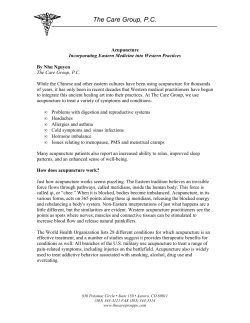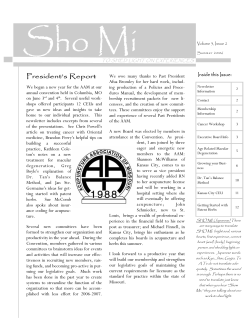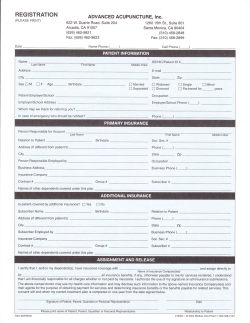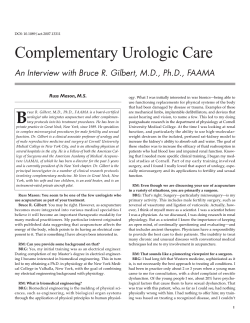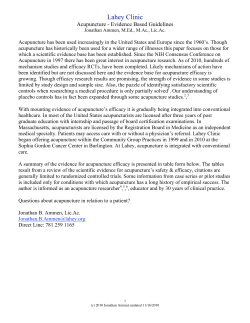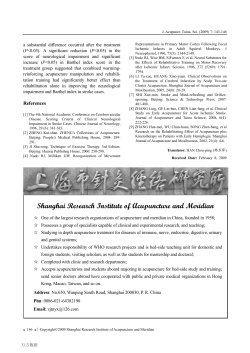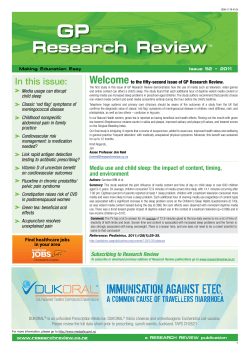
Cerebral Blood Flow Effects of Pain and Acupuncture: A Preliminary Single-Photon Emission Computed
10.1177/1051228404271005 Journal of Neuroimaging Vol 15 No 1 January 2005 Newberg et al: CBF Effects of Pain and Acupuncture Cerebral Blood Flow Effects of Pain and Acupuncture: A Preliminary Single-Photon Emission Computed Tomography Imaging Study Andrew B. Newberg, MD Patrick J. LaRiccia, MD Bruce Y. Lee, MD John T. Farrar, MD Lorna Lee, MA Abass Alavi, MD ABSTRACT Background. The purpose of this study was to investigate the cerebral blood flow changes associated with the analgesic effect of acupuncture in patients with chronic pain. Methods. Seven patients presenting with a chronic pain syndrome and 5 healthy controls were included. All single-photon emission computed tomography (SPECT) scans were acquired with a uniform protocol. The patient group was injected with the radioisotope HMPAO while experiencing their usual level of pain. A baseline scan was acquired approximately 20 minutes after administration of the HMPAO. The patient then underwent acupuncture therapy with needles placed in points specifically selected to relieve pain. When the pain improved, as determined by a 10digit score for pain assessment, the patient was reinjected with HMPAO and imaged 20 minutes later for the acupuncture scan. The reference group also had a baseline and acupuncture scan, although the acupuncture itself was performed using a standardized set of needle points. Results. The reference group participants were found to have significant increases in the thalamic and prefrontal cortex activity on the acupuncture scan compared to the baseline. The baseline scans of the pain patients Received April 27, 2004, and in revised form July 9, 2004. Accepted for publication August 11, 2004. From the Department of Radiology, University of Pennsylvania Health System (ABN, AA); the Department of Medicine, Presbyterian Medical Center–University of Pennsylvania Health System, and the Department of Rehabilitation Medicine, Hospital of the University of Pennsylvania–University of Pennsylvania Health System (PJL); the Department of Medicine, University of Pennsylvania Health System (BYL); the Department of Epidemiology and Anesthesia, University of Pennsylvania Health System ( JTF); and the Center for Health and Healing, Wilmington, Delaware (LL). Address correspondence to Andrew B. Newberg, MD, Division of Nuclear Medicine, Hospital of the University of Pennsylvania, 110 Donner Building, 3400 Spruce Street, Philadelphia, PA 19104. E-mail: newberg@ oasis.rad.upenn.edu. showed significant asymmetric uptake in the thalami compared to controls. This asymmetry reversed or normalized after the acupuncture therapy. Significant correlations were observed between the change of activity in the prefrontal cortex and ipsilateral sensorimotor area. Conclusion. The results from these cases show that HMPAO-SPECT is capable of detecting changes in cerebral blood flow associated with pain and that acupuncture analgesia is associated with changes in the activity of the frontal lobes, brain stem, and thalami. K ey words: A cupuncture, p ain, re gional c ere bral blood flow, SPE C T, HMPA O . N ewb erg A B, LaRic cia PJ, Le e BY, F arrar JT, Le e L, Alavi A. C ere bral blood flow effe cts of p ain and a cupuncture: a preliminary single-photon emission compute d tomogra phy ima ging study. J N euroima ging 2005;15:000-000. D OI: 10.1177/1051228404271005 Acupuncture has been used for thousands of years to treat pain and other health maladies. The World Health Organization recognizes the usefulness of acupuncture to treat several chronic pain syndromes.1 Limited data have suggested that although some chronic pain patients respond to acupuncture,2-5 the physiologic mechanisms and brain structures involved in acupuncture analgesic (AA) response are not well-understood. The growing use and success of acupuncture motivated the formation of a 1997 National Institutes of Health Consensus Panel on Acupuncture, which remarked on the relative poor understanding of the physiologic mechanisms involved and urged for more research to be performed.6 Reports in both animals and humans have suggested that AA may result from the activation and deactivation of a number of brain structures such as the lateral and posterior hypothalamus, the lateral septum, the dorsal hippocampus or medial centro-median nucleus of the thalamus, the arcuate nucleus, the ventral median nucleus of the Copyright © 2004 by the American Society of Neuroimaging 1 Table 1. Patient Characteristics Patient 1 2 3 4 5 6 7 Age, y Gender Duration of Pain, y 54 43 47 26 58 51 30 M F F F F F F 17 2 10 4 6 10 2 Pain Pain Level Level Preacupuncture Postacupuncture 5.0 8.0 7.5 8.0 7.0 6.0 8.0 2.5 4.0 3.0 4.0 5.0 4.0 3.0 Site of Pain Deltoid muscle with spasms Right upper back and neck radiating to head Diffuse Neck and right arm Left arm Low back and neck Low back and neck hypothalamus, the ventral part of the periaqueductal centra l g ra y , th e ra p h e m a g n u s , a n d re ti c u l a r paragigantocellular nucleus.7-9 Few studies in the North American literature have used functional imaging, such as single-photon emission computed tomography (SPECT), positron emission tomography, or functional magnetic resonance imaging (fMRI) to measure regional cerebral blood flow (rCBF) changes in human subjects during acupuncture, and none have explored the effects of acupuncture on chronic pain.10-12 Our study used SPECT to determine how rCBF changes in patients who experience relief of pain with acupuncture. depending on the location of the pain. Asymptomatic comparison participants had acupuncture on only the right side of the body in a set of standard points. Stainless steel 0.25 ! 30 mm disposable needles were inserted using a guide tube. The needles were left in place for 15 to 25 minutes, with the patients kept comfortable throughout the treatment. Methods S PECT Scan Acquisition Study Population Preacupuncture scan. Following informed consent, each participant received an intravenous administration of 260 MBq (7 mCi) of Tc-99m labeled HMPAO (Ceretec, Amersham Inc) while sitting quietly with their eyes open and ears unoccluded. Twenty minutes after the HMPAO administration, images of the participant’s brain were acquired over 45 minutes using a triple-headed camera equipped with ultra-high resolution, fan beam collimators (Picker 3000, Cleveland, OH). Projection images were obtained at 3-degree angle intervals on a 128 ! 128 matrix over 360 degrees by rotating each head 120 degrees. Images were reconstructed in the transaxial, coronal, and sagittal planes using ramp backprojection, a Weiner post filter set to 0.4, and Chang’s first-order attenuation correction (attenuation coefficient set at 0.11 cm–1).15 The reconstructed slice thickness was 10.7 mm. To ensure that we could correlate pain relief with rCBF, we selected patients that had prior documented response to acupuncture in the treatment of their pain syndromes. Patients had a history of chronic pain that had not been completely responsive to standard medical treatment (ie, nonsteroidal anti-inflammatory medications, tricyclic antidepressants, physical therapy, transcutaneous electrical nerve stimulation, and local steroid injections) for at least 2 years. Seven pain patients (1 male, 6 female; 26 to 58 years old) were included (see Table 1). Five healthy and asymptomatic volunteers (3 male, 2 female; 20 to 24 years old) who were free of any painful conditions were included as a reference group. These participants were not used as a matched control group to compare with the pain patients but represented another perspective on the neurophysiological correlates of acupuncture. Acupuncture Technique Each participant received acupuncture from the same acupuncturist (P.J.L.) using a traditional Chinese medicine point selection method of local and remote analgesic meridian points, which could be on either side of the body 2 Journal of Neuroimaging Vol 15 No 1 January 2005 Pain Assessment Participants were asked to rate their pain on a 10-digit numeric rating scale for pain intensity13,14 (0 = no pain, 10 = maximum pain) on 2 occasions: at baseline prior to the acupuncture and at the conclusion of the acupuncture treatment. Postacupuncture scan. Participants then received acupuncture treatments for 20 to 25 minutes. Immediately at the end of the acupuncture treatment, an intravenous dose of 925 MBq (25 mCi) HMPAO was administered. Approximately 20 minutes later, images of their brain were acquired over 30 minutes using the same protocol as the preacupuncture scan (Figs 1, 2). Of note, the small/ large dose scheme has been previously validated by other research groups for use in activation studies16,17 and has been used by our laboratory in previous studies with no Fig 1. These are several consecutive transaxial slices from single-photon emission computed tomography scans of patient 2 with baseline scan (top row) showing initial thalamic (arrow) asymmetry with the left activity greater than the right. The postacupuncture scan (bottom row) shows reversal of the thalamic asymmetry with the right now markedly greater than the left. significant differences observed in healthy controls when undergoing test-retest scans using small and large doses.18 S PECT Analysis The preacupuncture and postacupuncture scans were reconstructed and resliced according to the anterior-posterior commissure line so that the 2 scans from each participant were calibrated with respect to each other. A previously validated template of regions of interest (ROIs) was placed over the preacupuncture scan.19 The ROIs used for analysis included only those proposed to be involved in pain and acupuncture pathways including the dorsolateral prefrontal cortex, inferior frontal lobe, orbitofrontal lobe, dorsal medial cortex, insula, sensorimotor area, thalamus, anterior and posterior cingulate gyrus, inferior temporal lobe, medial temporal lobe, and midbrain. As such, the use of the ROIs was hypothesis driven, and therefore we did not test for multiple comparisons. In addition, we did not use statistical parametric mapping, an overly conservative approach, since the sample size was small and the expected differences were somewhat heterogeneous. The size of each ROI varies depending on the structure it is measuring, but each region is smaller than the structure itself and there- fore represents a “punch biopsy.” This helps reduce the problem of partial volume averaging and also makes the need for anatomic coregistration less important for the larger structures evaluated in this study. Each of the ROIs had its placement adjusted manually to achieve the best fit and were then copied onto the postacupuncture scan. Regional CBF values for the postacupuncture scan were obtained by determining the number of counts in each ROI and subtracting the number of decay-corrected counts in the same ROI on the preacupuncture scan. Counts per pixel in each ROI were normalized to wholebrain activity, which was determined by drawing ROIs around the entire brain on 5 slices centered on the thalamus. A percentage change was calculated for each ROI using the following equation: % Change = 100 ! Post acupuncture Pre acupuncture . Pre acupuncture A laterality index (LI) was calculated using the equation LI = 100 ! (Right Left) . 1 / 2 ! (Right + Left) Newberg et al: CBF Effects of Pain and Acupuncture 3 Fig 2. These are several consecutive transaxial slices from single-photon emission computed tomography scans of patient 2 with baseline scan (top row) showing initial thalamic (thick arrow) and basal ganglia (thin arrow) asymmetry with the right activity greater than the left. The postacupuncture scan (bottom row) shows normalization of the thalamic and basal ganglia asymmetry, with the both right and left having relatively equal activity. Statistical Analysis A series of paired t tests was performed to compare preacupuncture and postacupuncture rCBF for each ROI for within-group comparison. Spearman correlations were generated in both pain patients and reference controls to assess associations between changes in rCBF in different regions including homologous regions in both hemispheres. Spearman correlations were also generated to compare the LIs in brain structures between the preand postacupuncture scans. The activity in each ROI on the preacupuncture scan was also compared to the level of pain using the Spearman correlation. Since a relatively large number of significance tests were examined, all P values should be interpreted with caution. Results Asymptomatic Comparison Participants In asymptomatic participants, the thalami, dorsolateral prefrontal cortex (DLPFC), left insula, and inferior temporal lobes showed increased activity in postacupuncture 4 Journal of Neuroimaging Vol 15 No 1 January 2005 compared to preacupuncture scans (23%, 14%, 12%, and 27%, respectively; P < .05). Significant correlations were found between the change in activity in the thalamus and that in the ipsilateral sensorimotor cortex (P = .005) and the left thalamus and the left posterior cingulate gyrus (P = .049). The correlation between the right thalamus and the right posterior cingulate gyrus approached significance (P = .069). These participants reported no pain before or after the acupuncture treatment. There was no significant asymmetry in thalamic activity in the controls either before or after acupuncture. Chronic Pain Patients All pain patients had pain relief from acupuncture. The difference between pain scores before (mean = 7.6) and after acupuncture (mean = 3.0) was statistically significant (P = .004). Preacupuncture thalamic rCBF in pain patients was significantly more asymmetric than in nonpain patients (mean LI of 15.8 ± 9.6 and 3.0 ± 2.7, respectively; P < .05). The more asymmetric the thalamic activity was during pain, the more this asymmetry reversed after acupuncture reflected by a negative correlation between pre- and postacupuncture thalamic LIs (R = –0.82, P < .02). Significant correlations (P < .05) existed between changes in activity in the right thalamus and right posterior cingulate gyrus (R = 0.96); the DLPFC and ipsilateral sensorimotor cortex (R = 0.90); the right DLPFC and right midbrain (rs = 0.51); and the right anterior cingulate gyrus and right midbrain (R = .66). In pain patients, the change in pain between pre- and postacupuncture correlated negatively (P < .05) with the change in activity in the dorsal medial cortex (R = –0.85), DLPFC (R = – 0.96), and inferior frontal cortex (R = –0.85). Discussion Various electrophysiological and neurochemical animal studies have suggested that pain perception is mediated by a number of areas of the brain, including the thalamus, basal ganglia, nucleus accumbens, the ventral part of the periaqueductal central gray, the raphe magnus, and the reticular paragigantocellular nucleus.20 Using animal models, investigators have identified possible afferent and efferent pathways for AA. The afferent pathway identified included the dorsal part of the periaquiductal gray matter, the lateral septum, the dorsal hippocampus, the habenulo-interpeduncular tract, the centro-median nucleus of thalamus, the anterior hypothalamus, and, in the spinal cord, the contralateral antero-lateral tract.21-25 The efferent pathway includes the arcuate nucleus and the ventral median nucleus of the hypothalamus, the ventral part of the periaqueductal central gray, the raphe magnus, and the reticular paragigantocellular nucleus.26-28 There have been only a limited number of functional imaging studies on acupuncture in humans reported in the literature in the English language. There are a few additional studies published in foreign journals, particularly from Asia. Most studies used healthy volunteers rather than chronic pain patients. Moreover, the studies have reported on their evaluation of various forms of acupuncture (eg, electro-acupuncture), which may not be comparable. Zhang and colleagues found that electrical AA correlated with activation of the bilateral secondary somatosensory area and insula, the contralateral anterior cingulate cortex, and the thalamus.29 Depending on the electrical frequency used, other areas of the brain were affected as well. Using 11 healthy volunteers, Kong and colleagues also showed that electro-acupuncture produced fMRI signal increases in the precentral gyrus, the postcentral gyrus/inferior parietal lobule, and the putamen/insula.30 They found that manual needle manipulation produced prominent decreases of fMRI signals in the posterior cingulate gyrus, the superior temporal gyrus, and the putamen/insula. In 10 healthy volunteers, Siedentopf and colleagues found laser acupuncture to activate the cuneus corresponding to Brodmann area (BA) 18 and the medial occipital gyrus (BA 19) of the ipsilateral visual cortex.31 In 13 patients, Hui and colleagues found acupuncture produced fMRI signal decreases in the nucleus accumbens, amygdala, hippocampus, parahippocampus, hypothalamus, ventral tegmental area, anterior cingulate gyrus (BA 24), caudate, putamen, and temporal pole and fMRI signal increases in the somatosensory cortex.32 In 9 healthy participants, Wu and colleagues found that real acupuncture resulted in the activation of the hypothalamus and nucleus accumbens and deactivation of the rostral part of the anterior cingulate cortex, amygdala formation, and hippocampal complex. These changes were not found in 9 controls who received sham acupuncture.33 A few studies have used SPECT in humans to study the effect of acupuncture. Lee and colleagues used SPECT to determine rCBF changes in 6 patients with middle cerebral artery occlusion before and after acupuncture and compared these changes to those in normal controls. They found focally increased rCBF in the ipsilateral or contralateral sensorimotor areas and the hypoperfused zone surrounding the ischemic lesion in the stroke patients and in the parahippocampal gyrus, premotor area, frontal and temporal areas bilaterally, and ipsilateral globus pallidus in the normal controls.34 In a study of 11 healthy volunteers and 9 patients with cerebral vascular disease, Wang and Jia saw alterations in SPECT rCBF to the contralateral cerebral cortex and thalamus, the ipsilateral basal ganglion, and the cerebellum.35 Our results are consistent with the implicated role of the thalami, cingulate gyrus, DLPFC, midbrain, insula, and sensorimotor cortex in AA, but they demonstrate these changes in patients who present with pain and are known to respond to acupuncture therapy. The number of correlations between changes in activity in different structures also implicates a more integrated pathway that mediates pain and analgesia, specifically when associated with acupuncture. The prefrontal cortex, thalamus, and sensorimotor area were generally correlated with each other. The finding of alterations in thalamic asymmetry suggests the particular importance of the thalamus in the process of pain perception and analgesia. That patients with pain had significant asymmetries in thalamic activity, which either normalized or reversed after acupuncture, demonstrates the importance of the thalamus in mediating pain. However, due to our small sample size and the heterogeneity of pain symptoms, it was not possible to adequately determine how thalamic asymmetry directly related to the site of pain. Future studies of acupuncture in patients with more focal pain may help to fur- Newberg et al: CBF Effects of Pain and Acupuncture 5 ther elucidate the role of the thalamus in the physiological effects of acupuncture. Whether alterations in activity in these brain structures are the cause or result of AA is an important issue. In other words, it is not clear if the changes observed on our S P E CT study were related to a central neurophysiological mechanism of AA or were simply the result of pain alleviation by the acupuncture, which may have caused the analgesia by some peripheral mechanism. Furthermore, the theoretical basis of acupuncture at this time has no clear referent in terms of Western medicine, which makes any associations between neurophysiology and specific acupuncture concepts difficult to determine. This issue can be addressed in future controlled and blinded studies with larger sample sizes, placebo acupuncture, and comparison to other methods of achieving analgesia such as via pharmacological interventions. Although our study was a relatively small case series with patients selected because they had responded to acupuncture previously, the findings suggest certain areas of the brain, particularly those involved in pain pathways, should be targeted in future studies of the mechanism of acupuncture analgesia. Partial support for manuscript preparation by Dr LaRiccia from the Research Institute of Global Physiology, Behavior and Treatment, Inc, New York, NY (a nonprofit research foundation). References 1. Altshuler LH, Maher JH. Acupuncture: a physician’s primer, Part II. J Okla State Med Assoc 2003;96:13-19. 2. Carlsson CP, Sjolund BH. Acupuncture and subtypes of chronic pain: assessment of long-term results. Clin J Pain 1994;10:290-295. 3. Meng CF, Wang D, Ngeow J, Lao L, Peterson M, Paget S. Acupuncture for chronic low back pain in older patients: a randomized, controlled trial. R h e u m a t o l o gy ( O x f o r d ) 2003;42:1508-1517. 4. Chen R, Nickel JC. Acupuncture ameliorates symptoms in men with chronic prostatitis/chronic pelvic pain syndrome. Urology 2003;61:1156-1159. 5. Yong D, Lim SH, Zhao CX, Cui SL, Zhang L, Lee TL. Acupuncture treatment at Ang Mo Kio Community Hospital: a report on our initial experience. S i n g a p o r e M e d J 1999;40:260-264. 6. National Institutes of Health. Acupuncture. N I H Consens Statement 1997;15:1-34. 7. Pomeranz B, Stux G. Scientific Basis of Acupuncture. Berlin: Springer-Verlag; 1989. 8. Han JS, Terenius L. Neurochemical basis of acupuncture analgesia. Annu Rev Pharmacol Toxicol 1982;22:193-220. 9. Han JS, Tang J, Ren MF, Zhou ZF, Fan SG, Qiu XC. Central neurotransmitters and acupuncture analgesia. Am J Chin Med 1980;8:331-348. 6 Journal of Neuroimaging Vol 15 No 1 January 2005 10. Hsieh JC, Tu CH, Chen FP, et al. Activation of the hypothalamus characterizes the acupuncture stimulation at the analgesic point in human: a positron emission tomography study. Neurosci Lett 2001;307:105-108. 11. Yin L, Jin X, Qiao W, et al. PET imaging of brain function while puncturing the acupoint ST36. Chin Med J (Engl) 2003;116:1836-1839. 12. Li G, Cheung RT, Ma QY, Yang ES. Visual cortical activations on fMRI upon stimulation of the vision-implicated acupoints. Neuroreport 2003;14:669-673. 13. Breivik EK, Bjornsson GA, Skovlund E. A comparison of pain rating scales by sampling from clinical trial data. Clin J Pain 2000;16:22-28. 14. Paice JA, Cohen FL. Validity of a verbally administered numeric rating scale to measure cancer pain intensity. Cancer Nurs 1997;20:88-93. 15. Chang L. A method for attenuation correction in radionuclide computed tomography. I EEE Trans Nucl Sci 1978;25:638-643. 16. Ebmeier KP, Murray CL, Dougall NJ, O’Carroll RE, Goodwin GM. Unilateral voluntary hand movement and regional cerebral uptake of technetium-99m-exametazime in human control subjects. J Nucl Med 1992;33:1623-1627. 17. Ebmeier KP, Murray CL, Dougall NJ, O’Carroll RE, Goodwin GM. Unilateral voluntary hand movement and regional cerebral uptake of technetium-99-m-exametazime in human control subjects. J Nucl Med 1992;33:1623-1641. 18. Newberg A, Alavi A, Baime M, Pourdehnad M, Santanna J, d’Aquili E. The measurement of regional cerebral blood flow during the complex cognitive task of meditation: a preliminary SPECT study. Psychiatry Res 2001;106:113-122. 19. Resnick SM, Karp JS, Turetsky B, Gur RE. Comparison of anatomically-defined versus physiologically-based regional localization: effects on PET-FDG quantitation. J Nucl Med 1993;34:2201-2207. 20. Chudler EH, Dong WK. The role of the basal ganglia in nociception and pain. Pain 1995;60:3-38. 21. Takeshige C, Kamada Y, Hisamitsu T. Commonly responsive neurons in the periaqueductal gray matter and midbrain reticular formation of rabbits to acupuncture stimulation, inversion, pressure on body parts and morphine. Acupunct Electrother Res 1981;6:57-74. 22. Takeshige C, Kobori M, Hishida F, Luo CP, Usami S. Analgesia inhibitory system involvement in nonacupuncture point-stimulation-produced analgesia. B ra i n R e s B u ll 1992;28:379-391. 23. Takeshige C, Oka K, Mizuno T, et al. The acupuncture point and its connecting central pathway for producing acupuncture analgesia. Brain Res Bull 1993;30:53-67. 24. Rhodes DL, Liebeskind JC. Analgesia from rostral brain stem timulation in the rat. Brain Res 1978;143:521-532. 25. Balagura S, Ralph T. The analgesic effect of electrical stimulation of the diencephalon and mesencephalon. Brain Res 1973;60:369-379. 26. Takeshige C, Sato T, Mera T, Hisamitsu T, Fang J. Descending pain inhibitory system involved in acupuncture analgesia. Brain Res Bull 1992;29:617-634. 27. Mera T. The paragigantocellular nucleus as the decending pain inhibitory systemin the acupuncture analgesia. J Showa Med Assoc 1987;47:89-97. 28. Sato T, Mera T, Abe M, Takeshige C. The ventromedian nucleus of the hypothalamus as the descending pain inhibitory system. J Show Med Assoc 1982;46:59-64. 29. Zhang WT, Jin Z, Cui GH, et al. Relations between brain network activation and analgesic effect induced by low vs. high frequency electrical acupoint stimulation in different subjects: a functional magnetic resonance imaging study. Brain Res 2003;982:168-178. 30. Kong J, Ma L, Gollub RL, et al. A pilot study of functional magnetic resonance imaging of the brain during manual and electroacupuncture stimulation of acupuncture point (LI-4 Hegu) in normal subjects reveals differential brain activation between methods. J Altern Complement Med 2002;8:411419. 31. Siedentopf CM, Golaszewski SM, Mottaghy FM, Ruff CC, Felber S, Schlager A. Functional magnetic resonance imaging detects activation of the visual association cortex during 32. 33. 34. 35. laser acupuncture of the foot in humans. Neurosci Lett 2002;327:53-56. Hui KK, Liu J, Makris N, et al. Acupuncture modulates the limbic system and subcortical gray structures of the human brain: evidence from fMRI studies in normal subjects. Hum Brain Mapp 2000;9:13-25. Wu MT, Hsieh JC, Xiong J, et al. Central nervous pathway for acupuncture stimulation: localization of processing with functional MR imaging of the brain—preliminary experience. Radiology 1999;212:133-141. Lee JD, Chon JS, Jeong HK, et al. The cerebrovascular response to traditional acupuncture after stroke. Neuroradiology 2003;45:780-784. Wang F, Jia SW. Effect of acupuncture on regional cerebral blood flow and cerebral functional activity evaluated with single-photon emission computed tomography [in Chinese]. Zhongguo Zhong Xi Yi Jie He Za Zhi 1996;16:340-343. Newberg et al: CBF Effects of Pain and Acupuncture 7
© Copyright 2025



